
St. George Church (Photo: Emily O’Dell)
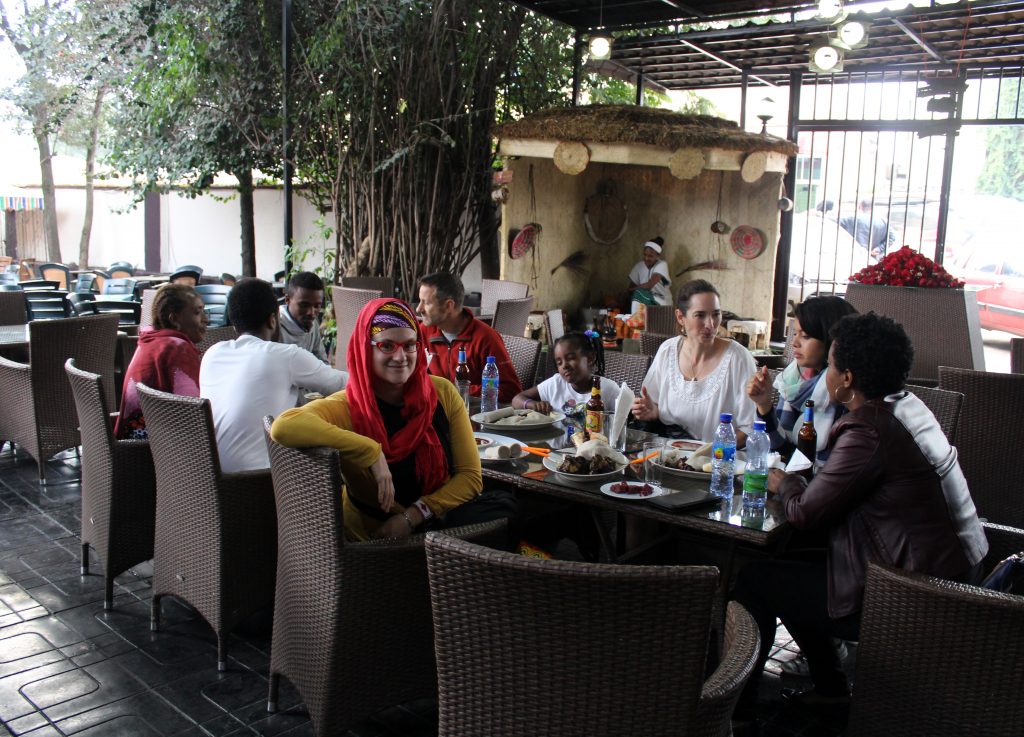
Addis Ababa food tour (Photo: Emily O’Dell)
My first excursion after touching down in Addis Ababa during the Eid holiday was a walking food tour of the capital. Culinary tourism is a new concept in East Africa, so I was especially excited to join with an enthusiastic group of Europeans and Ethiopians to visit three restaurants in one night to sample traditional vegetarian, fish, and meat dishes. Ethiopian food is my favorite cuisine in the world, so I was in absolute heaven as I went to grab my first piece of injera – the sponge-like sourdough bread that is used in place of a plate and utensils.
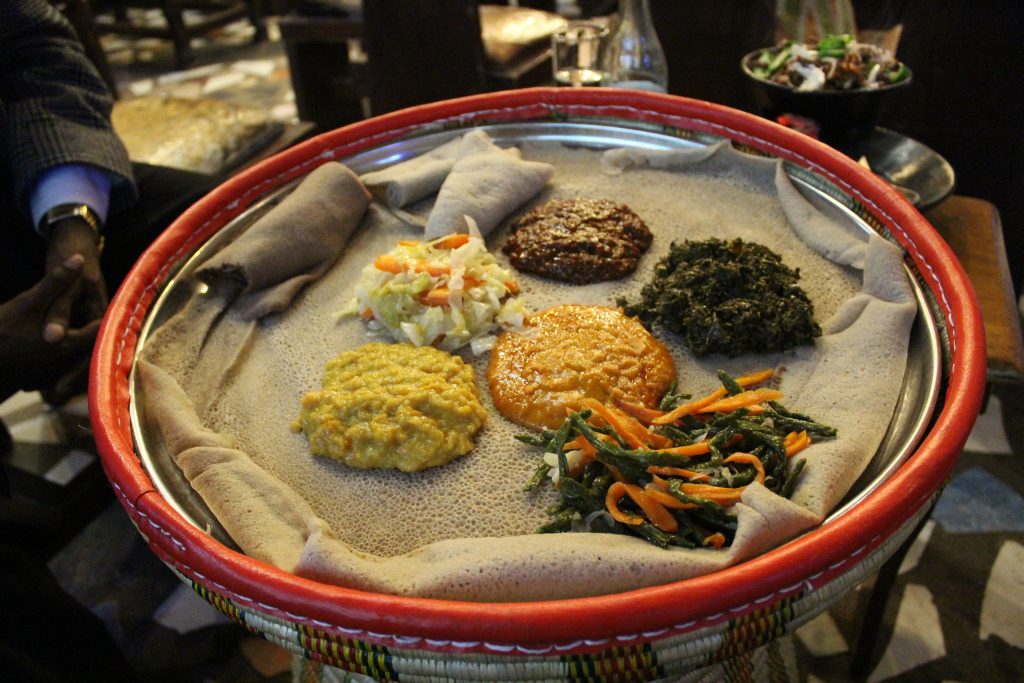
Vegetarian feast (Emily O’Dell)
Since I am vegetarian, I stuck to the palette pleasing globs of carrots, potatoes, cabbage, lentils, collard greens, string beans, split peas, and beets, while my new friends branched out and tried raw beef delicacies and Nile perch. My personal favorite dish is shiro – an orange chickpea stew cooked with berbere sauce — that I ended up eating every day of my trip. I am a total shiro addict and not ashamed.

Coffee and popcorn (Photo: Emily O’Dell)
Since many Ethiopians are Orthodox Christians and traditionally eat vegetarian dishes on Wednesdays and Fridays, all restaurants carry a “fasting menu” – a magnificent medley of meatless dishes – so vegetarians are always welcome. Our food tour concluded with a traditional coffee ceremony consisting of fresh brewed Ethiopian coffee and popcorn.

National Museum of Ethiopia (Photo: Emily O’Dell)
The National Museum was my first stop the following morning as I was eager to visit the home of “Lucy,” the famous partial skeleton of the most ancient early human – or hominin – ever found. In Amharic, Ethiopians call her Dinkinesh, which means “you are marvelous” — and she is. After studying the museum’s famed skeletons, ancient Sabaean inscriptions, and Emperor Haile Selassie’s enormous carved wooden throne, my guide and I headed up the eucalyptus lined road leading to Mount Entoto, the highest peak in Addis Ababa to explore Emperor Menelik II’s thatch-roofed palace, the technicolor striped church of Saint Mary, and the best vistas in the capital. We ended our day at Tomoca Cafe to sip the best coffee in the world.
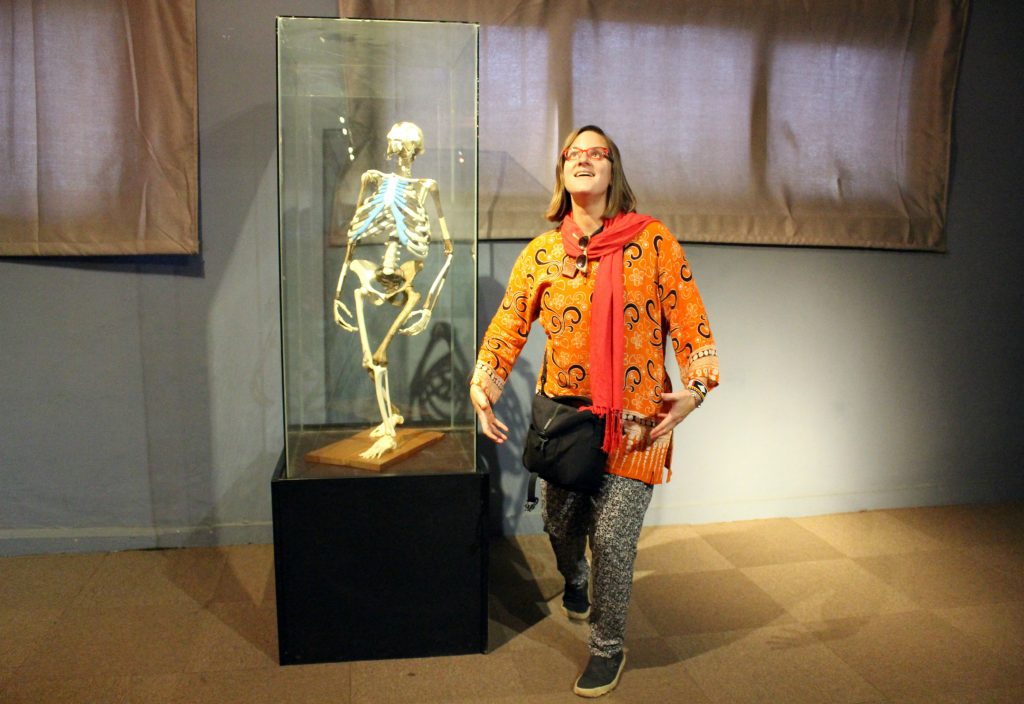
I love Lucy (Photo: Emily O’Dell)
The next day I flew north to explore Ethiopia’s famous UNESCO World Heritage Sites. First up was Axum, the center of the ancient Aksumite Kingdom, considered the holiest city in Ethiopia and thus a popular place of pilgrimage. I was most eager to see its ancient towering stelae, which are thousands of years old. As an Egyptologist, I felt right at home at this impressive archaeological site and delighted in contemplating its possible connections to ancient Egypt.
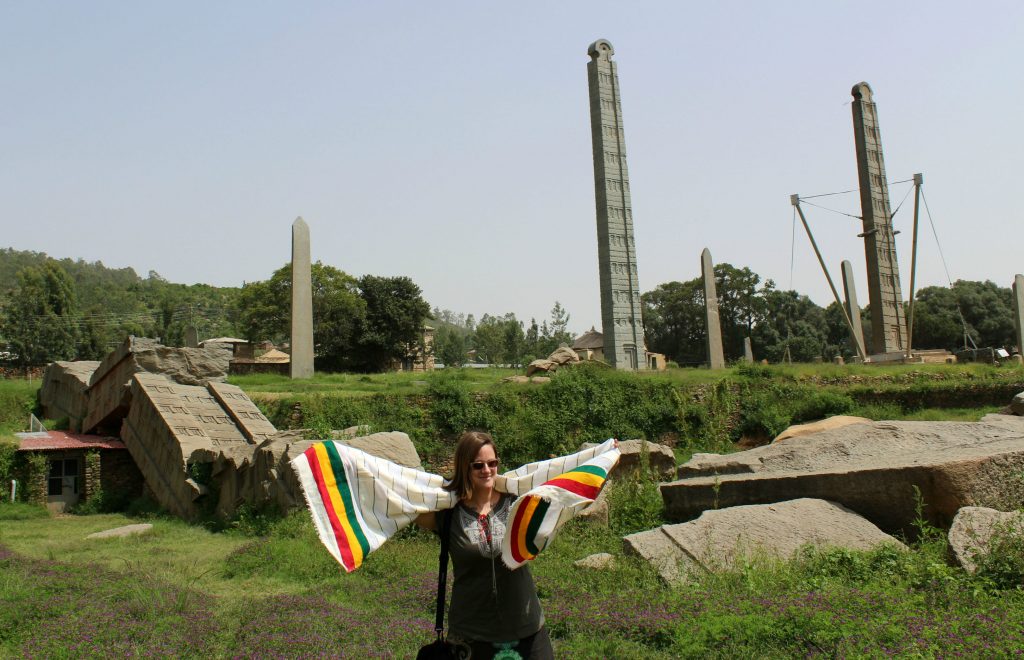
Stelae at Axum (Photo: Emily O’Dell)
Axum is chock full of archaeological sites – so bring your Indiana Jones hat when exploring its dark and dusty underground tombs and your reading glasses to marvel at the multilingual inscriptions on the 4th century Ezana Stone – which documents the conversion of King Ezana to Christianity and his conquest of ancient Sudan. This unique trilingual monument – often referred to as the Rosetta Stone of Ethiopia – features Ge’ez (Classical Ethiopic), South Arabian Sabaean, and Greek. We also wandered through the archaeological ruins believed by Ethiopians to be the palace of the Queen of Sheba and her royal bath, a solid rock hewn reservoir which has been used as a water source for millennia.
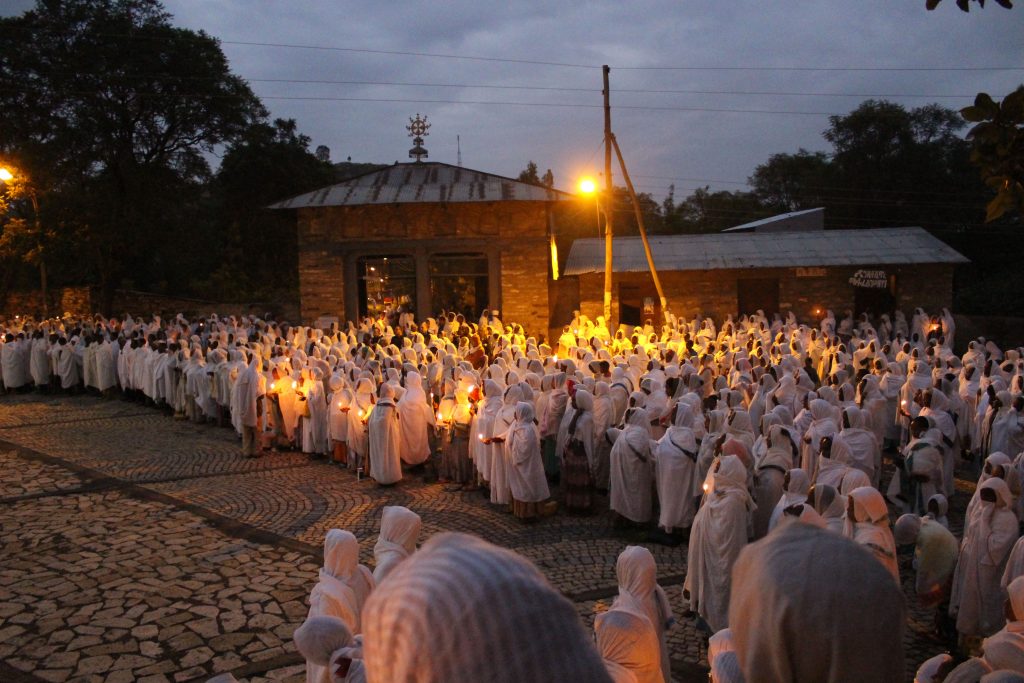
New Year’s mass (Photo: Emily O’Dell)
Lucky for me, I was in Axum for Ethiopian New Year, called “Enkutatash” in Amharic. This joyous holiday in September marks the end of the rainy season, when the yellow daisies dotting the hills are in full bloom. At 5 am, my guide and I slipped into the streets, and through the darkness spotted hundreds of people wrapped in white shrouds walking from all directions towards the outdoor mass in the city center. It was like Halloween but completely silent and with a somber and surreal feel. The priests processed regally through the sea of white bodies, carrying a replica of the Ark of the Covenant which they laid atop an altar as prayers were recited in Ge’ez. Each one of us lit a candle, which we carried with us as we marched through the streets in an orderly and spirited procession as the sun began to rise.
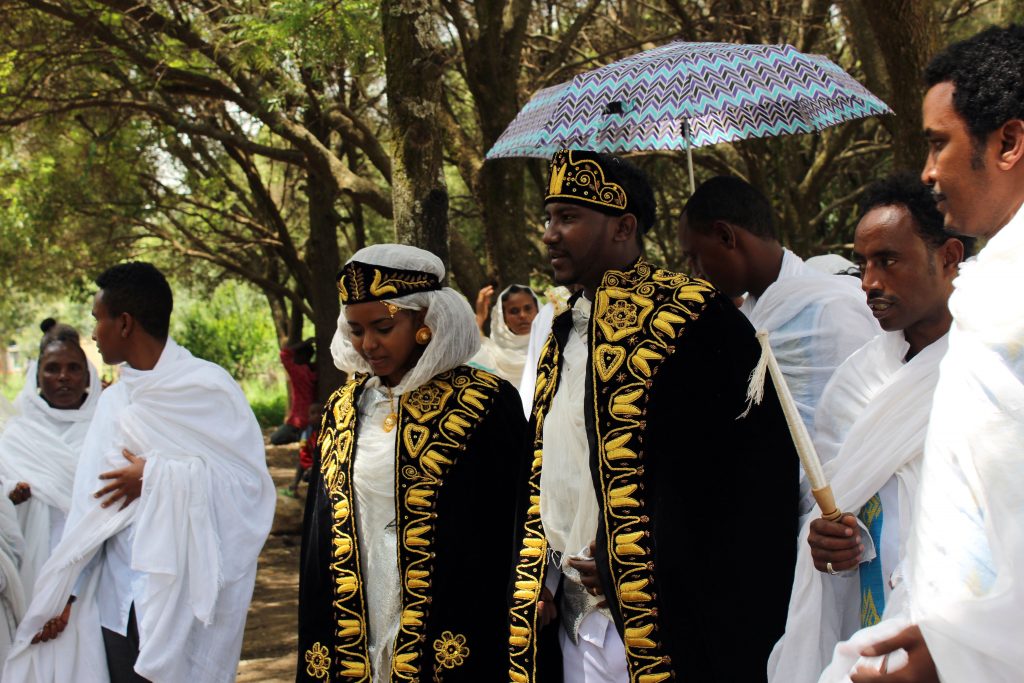
Wedding in Axum (Photo: Emily O’Dell)
Whether I was crashing a wedding to take photographs or asking for permission to study saintly paintings in religious manuscripts up close, everyone in Axum was very friendly and accommodating. I was even invited to attend choir practice, and watched with amazement as dozens of men sang while shaking silver sistrums — ritualistic rattles that go all the way back to Hathor and Isis cult worship in ancient Egypt. Since I was the first professor to teach Ge’ez (the liturgical language of Ethiopian Christians) in the modern Middle East while at the American University of Beirut, to behold sacred texts in situ written in this ancient Semitic language – the grammar and vocabulary of which is close to Arabic — was a dream come true.

Depiction of St. George (Photo: Emily O’Dell)
According to the Ethiopian Orthodox Tewahedo Church, the Biblical Ark of the Covenant – containing the stone tablets inscribed with the Ten Commandments — resides in the Church of Our Lady Mary of Zion. Accordingly, this church is where many Ethiopian emperors were crowned. When I got to the small unassuming building next to the main sanctuary where the sacred ark is believed to be kept (no one is allowed inside), the heavens literally opened wide – unleashing a torrent of rain which was a welcome blessing, since I hadn’t seen rain in the Sultanate of Oman for years.
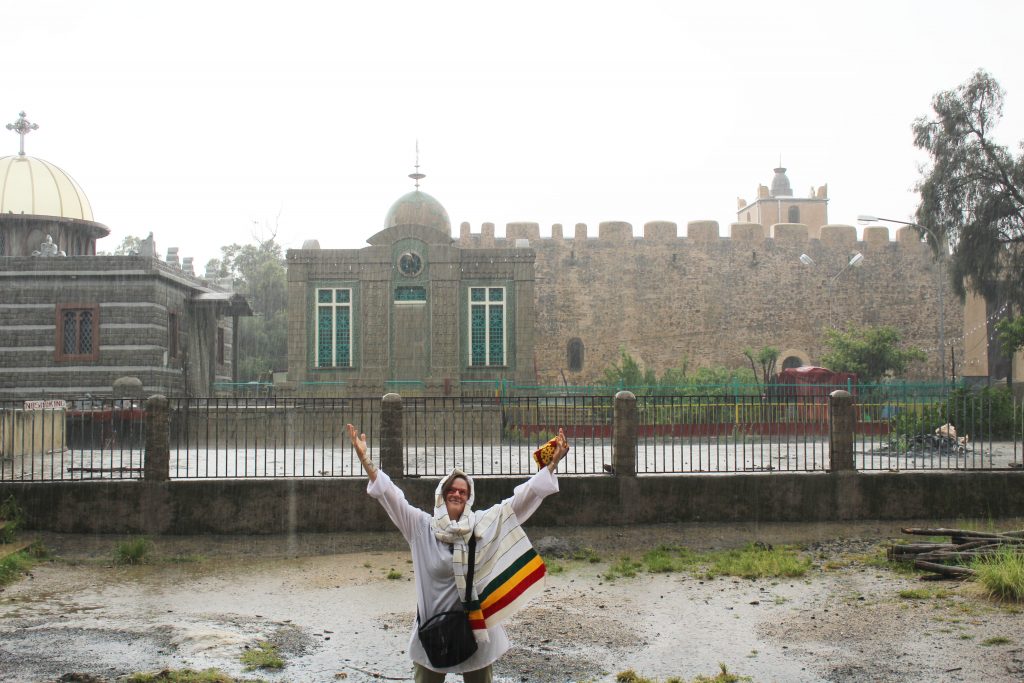
In front of the Ark of the Covenant building (Photo: Emily O’Dell)
After that sacred deluge, it was on to the UNESCO rock-hewn monolithic underground churches of Lalibela, named after King Lalibela, who tried to recreate Jerusalem in the Ethiopian highlands. Ethiopia claims to be the oldest Christian country in the world, since the state adopted Christianity in 330 AD. Weaving in and out of Lalibela’s otherworldly medieval churches magnificently carved from massive single pieces of rock made me feel like I was in Petra’s sister city. The moss-covered alleyways between the smooth rock walls brushed with a weathered blush offered plenty of natural stone seats in the shade from which to admire each of the eleven historic churches. Inside, the darkness was penetrated only by narrow beams of sunlight channeled through the cross chiseled windows. The most impressive church of all, of course, is St. George Church, carved in the shape of a Coptic cross from volcanic tuff and often called the Eighth Wonder of the World.

Speaking Ge’ez in Lalibela (Photo: Emily O’Dell)
A highlight of my trip was getting to speak Ge’ez with Ethiopian priests in Lalibela. As the liturgical language of the Ethiopian Orthodox Church, Ge’ez is used for religious purposes and rarely if at all for daily conversation — as the main language in Ethiopia today is Amharic. Imagine the surprise on the priests’ faces as I rounded the corners of these ancient churches speaking in Ge’ez and wanting to ask detailed questions about Ge’ez grammar in my book which I had, of course, brought along. These priests are the custodians not only of ancient chapels but also linguistic history. Teaching me how to shake a sistrum and parse Ge’ez grammar, these friendly Ethiopian priests made me even more gaga for Ge’ez than I had been before.
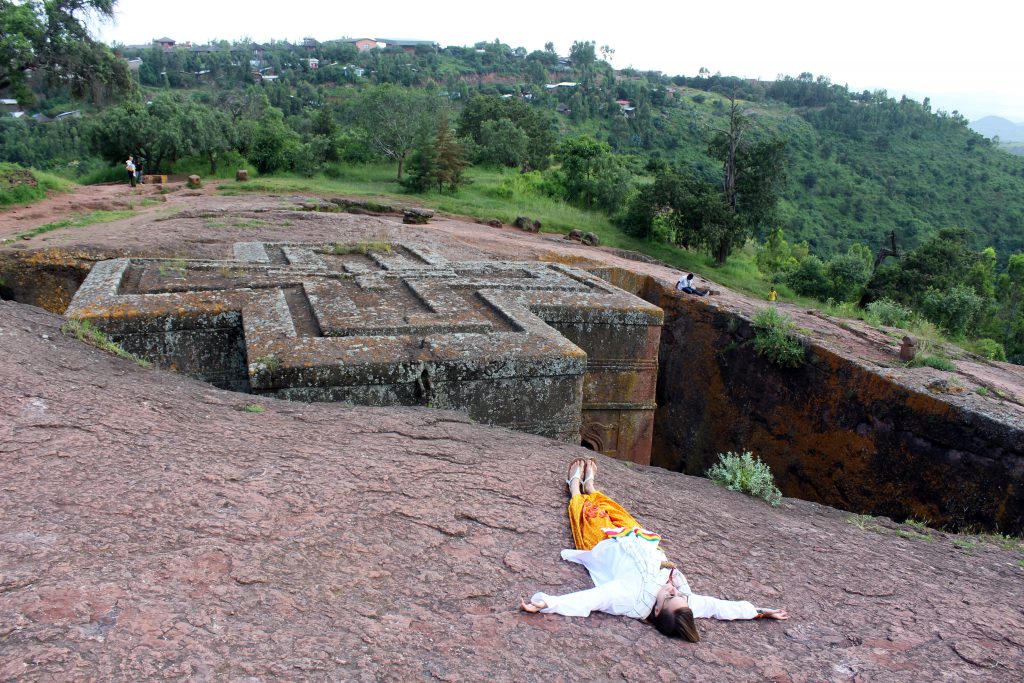
St. George Church (Photo: Emily O’Dell)
In the mood for a mummy adventure the next morning, I traveled twelve miles by car up Mount Abuna Yosef to Yemrehanna Kristos Church, an 11th century striped wonder made of stone and wood and tucked inside a sacred cave. What sets this church aside is the exquisite mural paintings – colorful crosses in entrancing geometric patterns considered the oldest in Ethiopia – decorating its striped arches and walls. Behind the church further back in the cave I came face-to-face with skeletons of countless monks and lay people wrapped in reed mats, some still with tuffs of hair on their heads. As an archaeologist, I marveled at their pearly whites, and turned on my flash to photograph their dusty bones.
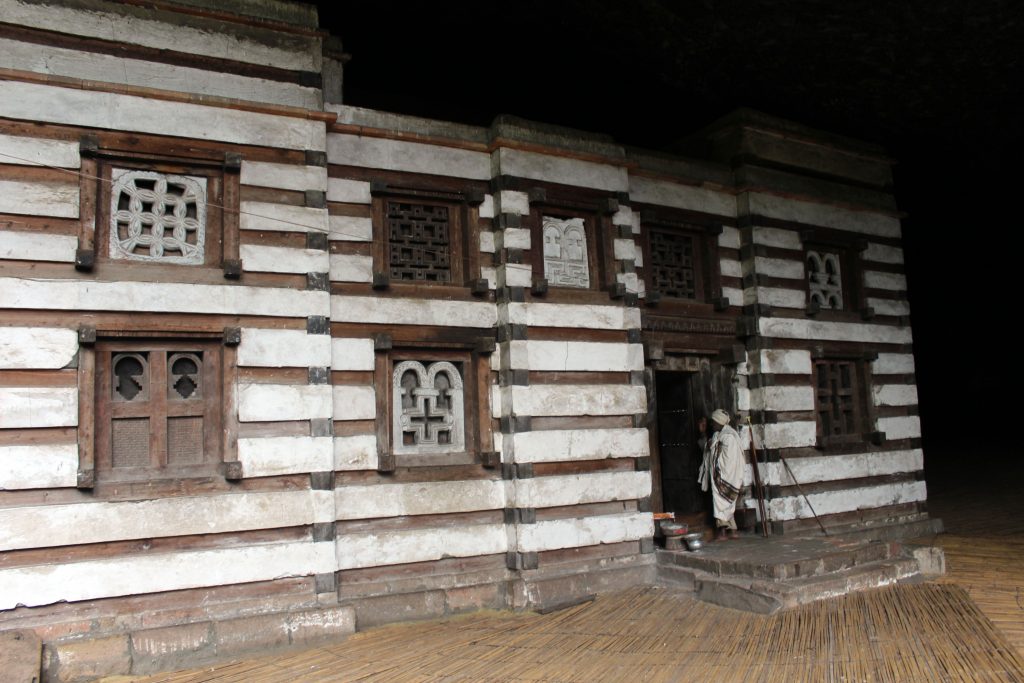
Yemrehanna Kristos Church (Photo: Emily O’Dell)
The main reason I had journeyed to Ethiopia was to celebrate Eid in Harar, the sacred Muslim city of Ethiopia. Pressed for time, I hopped on a plane in Lalibela to land in Harar the evening before Eid began. At early Eid prayers the next morning, the stadium floor was like a blooming garden with flowers blowing gently in the wind, as Ethiopian women decked out in abayas of every color bowed and rose in repeated prostrations. Afterwards, I joined with a group of friendly Sufis processing in the street and singing devotional songs to the beat of the East African drums they carried. Once we reached their Sufi lodge, we communed in an ecstatic zikr filled with soulful dance, devotional songs, and so many smiles.
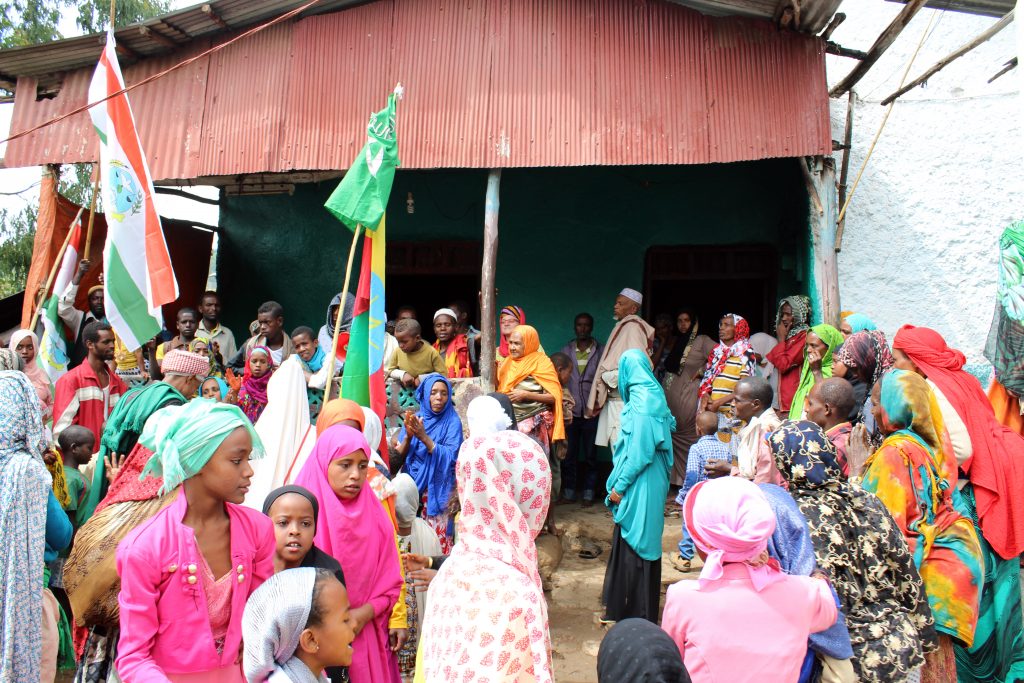
Zikr in Harar (Photo: Emily O’Dell)
As I whirled the next morning through Harar’s narrow, cobblestone streets, to the accompaniment of Arabic call of the muezzin, I marveled at the city’s small pastel houses, and let myself lose my way in the dizzying labyrinth. It was easy to see why the whole walled city is a UNESCO World Heritage Site. As women passed by with woven baskets and even mattresses balanced on their heads, I tried imagining what Harar was like in medieval times when Harar was a famed center of Islamic learning. I wandered by so many Sufi shrines I eventually lost count.

Whirling through Harar (Photo: Emily O’Dell)
Each alleyway boasts unusual architectural gems – like a small pink and purple mosque that reminded me of a wedding cake, and dome like homes that looked like alien space ships had landed unnoticed. To my surprise, I also found a few bed and breakfasts tucked away, traditional homes designed to give visitors the authentic experience of living in the medina instead of staying in a hotel. At night, tourists tend to venture to the walls of the city to watch locals feed hyenas from their own mouths!
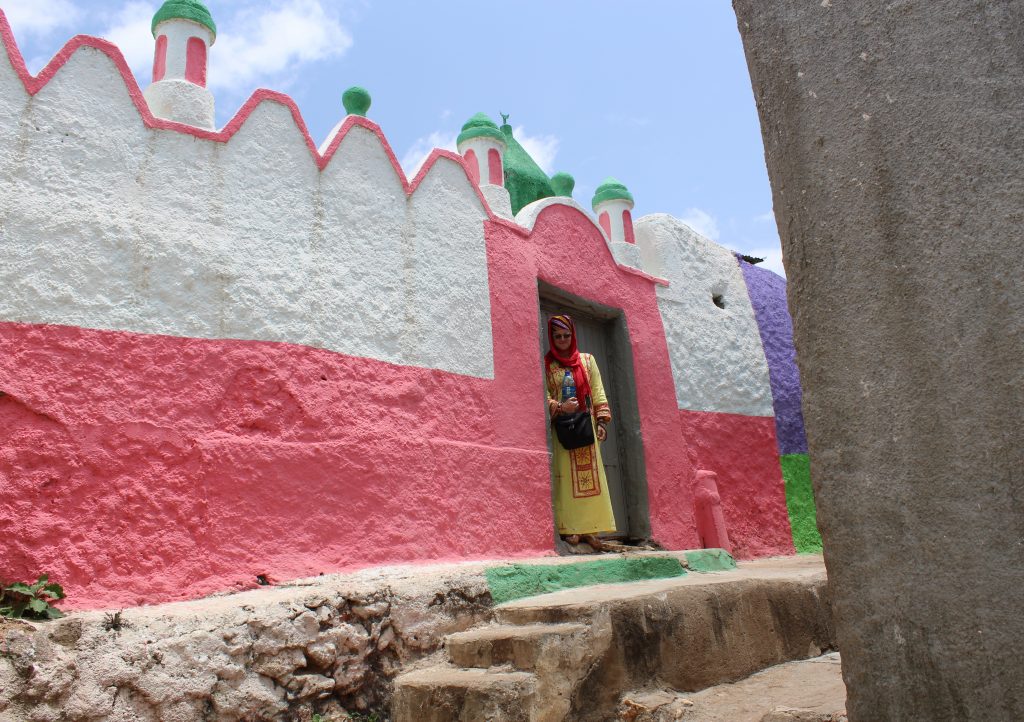
Mosque in Harar (Photo: Emily O’Dell)
For my research on the French poet Arthur Rimbaud, I paid a visit to the Rimbaud Museum – housed on the site where he once lived while gun-running in East Africa long after having turned his back on poetry. As I was interviewing the museum’s director, a huge gust of wind blew through the entire house violently slamming the windows open and shut like in a horror movie. Papers began to blow around, and biblical rumbles of thunder made us fear the whole wooden house would crash down upon us. “Look at that — you’ve awakened the spirit of Rimbaud, and he’s here with us now!” the director exclaimed, hurriedly trying to close all the windows as it began to pour.
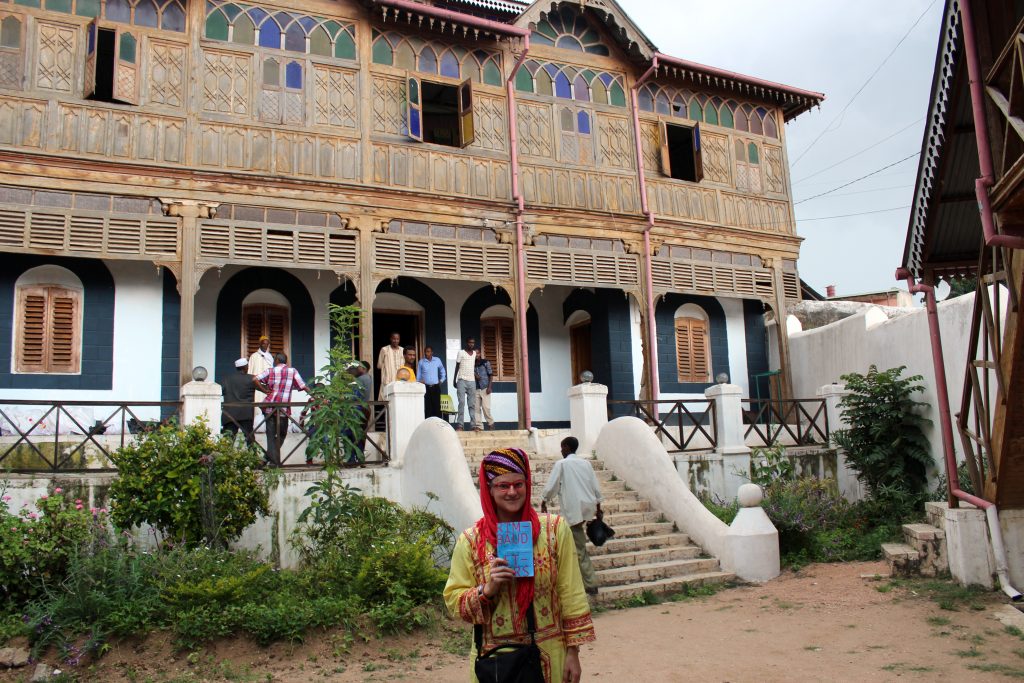
Rimbaud Museum (Photo: Emily O’Dell)
When we got back to Addis Ababa, I had one last thing to do – go shopping. My guide knew I had been on the hunt for the finest Ethiopian clothes, and he kept reassuring me that he knew the perfect place in the capital. As he drove me around the grounds of a dilapidated old hospital, I feared he had misunderstood me. Imagine my surprise when we rounded a corner at the hospital, and there before us was the most chic boutique I had seen in all of Ethiopia. Even cooler – this hip store, run by a German NGO, was filled with high-end designs and textiles made by Ethiopians with leprosy who had been successfully treated at the hospital. I justified my shopping spree comforted by the knowledge that I was helping support Ethiopians with disabilities.
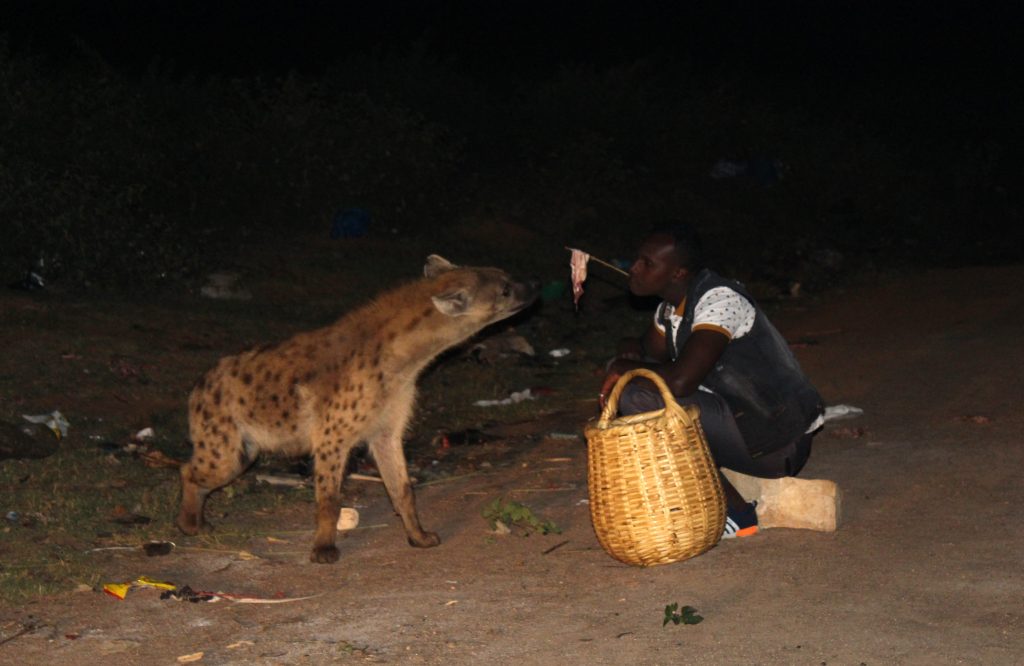
Hyena feeding in Harar (Photo: Emily O’Dell)
As a parting gesture, my guide gave me the best gift of all – cooking lessons in his family’s home. Alongside his wife, I learned how to make injera – though my first attempt at making this pancake like bread was marked by an abundance of batter splatter. To make the shiro, we combined fresh chickpea powder, garlic, onions, and berbere into a pan which I stirred with great anticipation, hungry as a hyena in Harar to taste my own creation. To top it all off, his 11-year-old daughter taught me how to brew traditional Ethiopian coffee – and to this day, I have not tasted a cup of coffee as savory as hers. As we sat down to break bread together, we feasted on the magical moments of my grand Ethiopian adventure, and began to plan my next trip to visit Omo Valley Tribes in the south. One visit to Ethiopia is really not enough — you will want to keep coming back for more.

Shiro at home (Photo: Emily O’Dell)